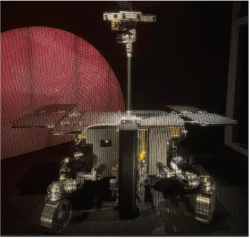The Petri Dish – Is there life on Mars?
Extraterrestrial life is something that has been extensively studied. Our human fascination with the search for extraterrestrial life – to see if we are not alone in this universe – has spanned decades, if not centuries. Alien life suffuses our entertainment and culture, and most people will agree that they have some hope, if any, that life exists beyond Earth.
Astrobiology is the study of life on Earth and in space: namely, the genesis, location, and evolution of life are the main fields astrobiologists aim their research. It is worth noting that life has never been found anywhere but on Earth; however, this is not to say it is impossible that life could exist outside of our atmosphere. Mars, Enceladus, and Europa are but a few of the celestial bodies being scrutinised by astrobiologists in their search for life beyond Earth. But how are these planets and moons investigated? How do aeronautical engineers and biologists come together to solve the complex questions of life? And how do we use model organisms on Earth to study how life could exist and function in the extreme environment of outer space? Well, luckily for you, answers to all of these questions can be found in this article!
How do we investigate life beyond our planet?
Scientists use robotic exploration to look for life at ground level on celestial bodies. The most well-known examples of this are the Martian robots produced by NASA (Perseverance and Curiosity). These robots use direct searches to analyse soil and rock samples.
An entirely new rover – the Rosalind Franklin – will be deployed in 2028, containing the most technologically advanced equipment on a rover to date
In 2012, Curiosity had a rocky descent (no pun intended) through the Martian atmosphere, nicknamed its “seven minutes of terror”. On Mars, it takes seven minutes for the rover to get from the top of the atmosphere to the surface of Mars, going from 13,000 miles an hour to zero, in perfect sequence. After a successful landing in 2012, it is currently positioned in the Gale Crater, using its Sample Analysis at Mars (SAM) instruments to take mass spectrometry and gas chromatography readings of the Martian geology (you can track precisely where the rover is using this tool)! After these samples have been taken, NASA’s Mars Sample Return mission is planned to bring material back to Earth in order to precisely test it for signs of life, involving both astrobiologists and microbiologists analysing the samples. So far, there have been 30 out of 38 Martian sample tubes collected, but Curiosity will continue to be operational until its hardware begins to degrade.

Figure 1: The ExoMars Rosalind Franklin Rover, Lara Bower / The Boar

Figure 2: PanCam filter wheel, Lara Bower / The Boar
Besides Curiosity, an entirely new rover – the Rosalind Franklin – will be deployed in 2028, containing the most technologically advanced equipment on a rover to date. Excitingly, I visited a 1:1 ratio model of the rover in the Natural History Museum in London and was able to see many of the rover’s components up close. Part of the display included onboard panoramic cameras (Figure 2), that use 11 colour camera filters to reveal different features of the landscape. The large black box at the front of the rover is the drill component (Figure 1) will gather samples from below the Martian surface, which are then transferred to the onboard Mars Organics Molecule Analyser (MOMA) ovens, to be heated. Once heated, vapour released can be analysed to test for traces of organic compounds.
Dimethylsulfide was detected on this exoplanet – a gas only produced by life, primarily by marine microbes
Beyond direct contact with planets, moons, and other celestial bodies, we can use remote sensing and planetary observation to characterise and detect exoplanets. Transit photometry can be used to measure dips in the levels of starlight when a planet passes in front of its star, revealing its size and orbit: the Kepler Telescope and the James Webb Space Telescope (JWST) are past and present telescopes respectively, that have discovered over 2,600 exoplanets. In particular, the JWST is a state-of-the-art modern telescope, doing follow-up studies on previously identified exoplanets. It can identify and analyse biosignature gases (gases that are indicative of life): on K2-18b, a potentially habitable exoplanet, it has found a wide range of gases that could be produced from both organic and inorganic sources, like methane and carbon dioxide. Excitingly, dimethylsulfide was detected on this exoplanet – a gas only produced by life, primarily by marine microbes. Further observations are needed to confirm the presence of these gases and rule out alternative abiotic (non-biological) explanations.
Life on Earth mirrors life in space
These ‘extremophiles’ have specific mechanisms that let them survive such hot and pH unstable environments
When life began on Earth – around 3.5 billion years ago – it was very different to the life we know on Earth today. It was not what we know as complex life: the organisms were single-celled, had no nucleus, and didn’t even use DNA to store their genetic information. However, scientists postulate that complex life formed when a single-celled ‘archaeon’ wrapped itself around a bacterium. The bacterium’s ability to generate energy through aerobic respiration was a huge advantage, leading to a symbiotic relationship where the bacterium became the mitochondria. This theory is known as endosymbiosis and is one of the leading theories of the evolution of life from single-celled organisms.
These single-celled organisms and fused bacteria-archaea primarily hung out around hot springs, using carbon compounds that were accumulating in Earth’s early oceans. Organisms like these still exist by hot springs: these ‘extremophiles’ have specific mechanisms that let them survive such hot and pH-unstable environments. Scientists can then use environmental clues – like fossil and geochemical analysis – to understand more about the genesis of these organisms. These techniques give an insight into how these early organisms survived and thrived. Thus, we can use extremophiles as model organisms to study how life could form in extreme conditions on other planets. Therefore, the form life may take – if we ever find it – will probably be far from green aliens and closer to those single-celled bugs we had living in Earth’s early oceans.

Comments